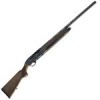Beretta A300 Outlander Wood Beretta Owner Manual A300 Outlander - Page 16
Obstruction / Choke Tubes, Condition Check, Assembly Of Packaged Firearm
 |
View all Beretta A300 Outlander Wood manuals
Add to My Manuals
Save this manual to your list of manuals |
Page 16 highlights
EN 14 OBSTRUCTION / CHOKE TUBES CONDITION CHECK Check the barrel to ensure there are no obstructions in the chamber and bore. This is extremely important because serious injury can result to the user or to nearby persons if a cartridge is fired in an obstructed barrel or chamber. Check the inside of the barrel prior to completely assembling the firearm and before use; if the firearm is already assembled the following procedure should be followed: • Follow the instructions in the "Disassembly" section and remove the barrel from the shotgun. • After removing the barrel, look right through the barrel from the rear and make sure there are no obstructions, even minor ones. • If an obstruction in the barrel is detected, a competent gunsmith must remove the obstruction. Inspect again the shotgun before it can be fired. • Remount the barrel, following the instructions set out in the "Reassembly" section. CHECKING THE CONDITION OF THE CHOKE TUBES • Always check the appearance and cleaning of the choke tubes before using the shotgun. • Check correct tightness in the barrel with the spanner provided. • Never use choke tubes that show signs of defects, warping or incrustation. • Make sure that the choke tube inserted is appropriate for the intended use and shot type to be used (steel or lead). See "Ammunition" chapter. ASSEMBLY OF PACKAGED FIREARM CAUTION: THIS FIREARM HAS THE CAPABILITY OF TAKING YOUR LIFE OR THE LIFE OF SOMEONE ELSE! ALWAYS BE VERY CAREFUL WHEN HANDLING YOUR FIREARM. AN ACCIDENT IS NEARLY ALWAYS THE RESULT OF FAILURE TO COMPLY WITH SAFETY rules, OR INCORRECT USE. WARNING: Beretta assumes no liability for any injury or damage to property resulting from improper or careless handling, or intentional or accidental firing of the shotgun. WARNING: All assembly, disassembly and maintenance procedures should be carried out with the firearm unloaded (cartridge chamber, receiver and magazine empty). Inspect the firearm by looking through the ejection port, the loading gate and the chamber.















